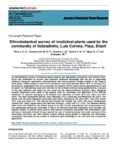Por favor, use este identificador para citar o enlazar este ítem:
http://www.alice.cnptia.embrapa.br/alice/handle/doc/1030073| Título: | Ethnobotanical survey of medicinal plants used by the community of Sobradinho, Luís Correia, Piauí, Brazil. |
| Autor: | SILVA, J. D. A.  NASCIMENTO, M. G. P.   GRAZINA, L. G.   CASTRO, K. N. de C.   MAYO, S. J.   ANDRADE, I. M.   |
| Afiliación: | Silva J. D. A., Independent Professional, Parnaíba, PI.; Nascimento M. G. P., Independent Professional, Parnaíba, PI.; Grazina L. G., Biochemist, Independent Professional, Coimbra, Portugal.; KARINA NEOOB DE CARVALHO CASTRO, CPAMN; Mayo S. J., Herbarium, Royal Botanic Gardens, Kew, Richmond, Surrey, TW9 3AE, U.K.; Andrade I. M., Herbário Delta da Parnaíba-HDELTA, Universidade Federal do Piauí, Campus Ministro Reis Velloso, Parnaíba-PI. |
| Año: | 2015 |
| Referencia: | Journal of Medicinal Plants Research, Nigeria, v. 9, n. 32, p. 872-883, Aug. 2015. |
| Descripción: | An ethnobotanical survey of medicinal plants used by the Sobradinho community, Luís Correia, Piauí, Brazil was undertaken to recover and document traditional knowledge with the aim of supporting chemical, biological, agronomic, pharmaceutical and socio-economic studies related to the region's biodiversity. Fifteen research visits to the community were made between March 2013 to January 2014 involving 31 respondents from the community, the majority (74.4%) being women aged between 27 and 84 years. The methodology used was interview by the snowball method using questionnaires. Analysis of the data gathered was based on use value and the Shannon-Wiener diversity index. Botanical voucher specimens were made of the species cited by informants and deposited at the HDELTA herbarium. 57 species belonging to 33 families were identified, of which 56% were native and 44% exotic. The best represented families were Fabaceae (14%), Lamiaceae and Myrtaceae (9% each). The leaves were the most frequently used plant parts (69%), followed by the stem (22%), fruit (4%), flower (2%), root and seed (1%). The species that showed the highest use value (VU) were Cymbopogon citratus (DC.) Stapf (capim-santo) and Morinda citrifolia L. (noni) with VU = 0.26. The Shannon-Wiener index value was highest for the elderly group (n=15, 48% of total respondents), but young people were not represented among the informants. A total of 67 different medicinal indications were recorded, the highest number of species being used to treat medical conditions associated with inflammation, pain and fever. Informants claimed to have learned the use of medicinal plants from older members of the community and there was little interest evident among young people in acquiring this knowledge. Community informants are the holders of medicinal plant knowledge of the local flora and its practical application. |
| Thesagro: | Etnobotânica Planta medicinal |
| NAL Thesaurus: | Ethnobotany Medicinal plants |
| Palabras clave: | Diversidade biológica Florística Biological diversity Floristics |
| ISSN: | 1996-0875 |
| DOI: | 10.5897/JMPR2015.5881 |
| Tipo de Material: | Artigo de periódico |
| Acceso: | openAccess |
| Aparece en las colecciones: | Artigo em periódico indexado (CPAMN)  |
Ficheros en este ítem:
| Fichero | Descripción | Tamaño | Formato | |
|---|---|---|---|---|
| ArtigoKarinaNeoobJournalMedicalPlantsResearch2015.pdf | 751,9 kB | Adobe PDF |  Visualizar/Abrir |









